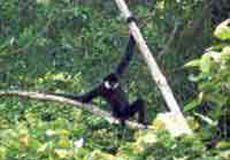Leaving behind the noise and the dust of the city, we escaped to Cuc Phuong National Park - the place of Vietnam’s capital in the 10th century - to immerse ourselves in nature and breathe in the fresh air of the vast, green forest.

Cuc Phuong National Park, 120km south of Hanoi, is located in the center of the Tam Diep mountain range. It’s so big (22,200ha) that it’s situated in three provinces, Ninh Binh, Hoa Binh and Thanh Hoa.
The park is surrounded by 300-400m high limestone hills and has within it a number of microclimates and unique ecosystems. The place is also of cultural and historical value and attracts both domestic and foreign visitors.
The native of the area who guided us on our excursion told us that the best time to visit the park is between December and the end of April when it’s not raining. At that time, one can hear birds singing and gibbons calling from high up in the treetops.
From the top of one of the Tam Diep hills, one can look out over the entire national park. Cuc Phuong is home to thousand-year old trees such the Parashrea stellata and Dracontomelum duperranum, dozens of varieties of orchids and also rare langurs, squirrels, spotted deer, and butterflies.
Cuc Phuong National Park has a rich fauna and a diverse flora. There are nearly 2,000 varieties of plant life and the forest has five layers. In the park there are 450 species of vertebrates which account for 38 percent of all animal species found in Vietnam.

Cuc Phuong forest was given reserve status in 1960 and in 1966 it became the country’s first national park. Within the park are the Trang Khuyet, Con Moong, Pho Ma and Nguoi Xua caves, each beautiful in its own way.
The most attractive cave is perhaps Nguoi Xua which has a 45m high ceiling and was used by prehistoric people. In 1966 the Vietnam Institute of Archaeology and Cuc Phuong National Park personnel excavated the cave and found many axes and knives made of stone, shell, animal bone and teeth.
They also found three tombs with intact human skeletons. Radiocarbon dating showed the skeletons to be about 7,500 years old. The corpses were found in a curled up position kept in place by stones. When buried they were placed on crushed stone and covered with celandine plants. These are the first ancient tombs to have been found in Vietnam.
Nguoi Xua Cave is home to 19 bat species and locals call the cave Hang Dang (’Hang’ in Vietnamese means cave, and ’Dang’ in Muong means bat). Inside the cave are beautiful stalactites of many shapes. Domestic visitors enjoy hitting upon the stalactites to make a sound that is like a gong.
Visitors to Nguoi Xua Cave are reminded that humans have been around for quite some time. They come to the cave and burn incense to commemorate the ancients and then contemplate the imposing scenery of the vast, green forest of Cuc Phuong.